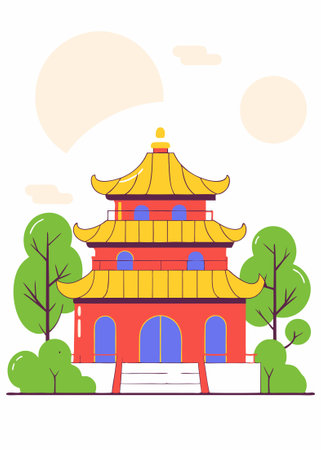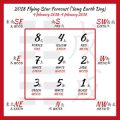1. Introduction to Feng Shui in the United States
Feng Shui, which means “wind and water” in Chinese, is an ancient practice rooted in the idea that our surroundings influence our well-being, luck, and success. Originally developed thousands of years ago in China, Feng Shui was used to design buildings, arrange furniture, and select sites for homes and graves by considering how energy—known as “Qi”—flows through spaces. Over time, this tradition has made its way across the globe and found a unique place within American communities.
In the United States, Feng Shui began to gain attention in the late 20th century as people became more interested in holistic living and Eastern philosophies. Today, it is not uncommon to see Feng Shui consultants working with homeowners, businesses, and even city planners. Americans have adapted Feng Shui principles to fit their lifestyles and cultural values while still respecting its roots.
The journey of Feng Shui into American culture involves blending traditional Chinese symbols with Western décor preferences. Many people incorporate popular Feng Shui items—like lucky bamboo plants or crystal spheres—into their homes and offices. These decorations are not just for aesthetics; they are believed to attract positive energy and create a balanced environment.
Key Foundations of Feng Shui
| Concept | Description |
|---|---|
| Qi (Chi) | The vital life force that flows through all things |
| Yin & Yang | Opposing but complementary forces that must be balanced |
| Five Elements | Wood, Fire, Earth, Metal, Water—each influences energy differently |
| Bagua Map | An energy map used to analyze spaces and guide decoration placement |
As more Americans embrace Feng Shui, they find creative ways to blend these principles with local customs and modern design. This cultural integration has helped make Feng Shui accessible and relevant for people from all walks of life in the US.
2. Popular Feng Shui Symbols and Their Meanings
Feng Shui is filled with unique symbols that are believed to attract positive energy, luck, and prosperity. In the United States, many people enjoy incorporating these symbols into their homes and offices not only for their beauty but also for their cultural meaning. Here are some of the most iconic Feng Shui symbols and what they represent:
Iconic Feng Shui Symbols
| Symbol | Description | Traditional Significance |
|---|---|---|
| Dragon | A mythical creature known for its strength and power. Often seen in statues or paintings. | Represents protection, authority, and good fortune. Placing a dragon in the home is thought to bring success and safeguard against negative energy. |
| Laughing Buddha | A cheerful, large-bellied figure, usually depicted laughing or smiling. | Symbolizes happiness, abundance, and contentment. The Laughing Buddha is often placed near entrances to welcome joy and wealth. |
| Money Frog (Three-Legged Toad) | A frog with three legs, often holding a coin in its mouth and sitting on a pile of coins. | Believed to attract money and financial luck. Traditionally placed near the front door, facing inward to invite wealth into the space. |
Bringing These Symbols into American Homes
Many Americans enjoy decorating with these Feng Shui symbols as part of their interior design. Whether displayed as art pieces or small figurines, these items can add both cultural flair and a sense of well-being to any space. Its common to see these symbols in living rooms, entryways, or even office desks as a way to blend tradition with modern American lifestyle.
![]()
3. Adapting Feng Shui Decorations in American Homes
Feng Shui has found a unique place in the world of American interior design. Homeowners and designers are blending traditional Feng Shui symbols with modern aesthetics, creating spaces that honor both Eastern wisdom and Western style. This approach allows for harmony, balance, and positive energy while still keeping the look fresh and relevant to American culture.
How Feng Shui Elements Are Used in Modern American Interiors
Many people in the US appreciate the benefits of Feng Shui but want to avoid an overly “themed” or traditional Chinese look. Instead, they select specific symbols or decorations that fit naturally into their homes. These can be subtle touches or statement pieces, depending on personal taste. Here are some common ways Feng Shui is adapted:
| Feng Shui Element | American Adaptation |
|---|---|
| Bamboo Plants | Used as minimalist decor on desks or entryways for luck and vitality |
| Water Features | Modern fountains or small aquariums placed near home entrances to attract prosperity |
| Crystals | Clear quartz or amethyst displayed on shelves for clarity and calmness |
| Mirrors | Decorative mirrors used to expand light and energy, often framed to match contemporary styles |
| Wind Chimes | Sleek metal or wooden wind chimes hung by windows or patios for gentle energy flow |
| Red Accents | Pillows, candles, or art with red tones added for good fortune without overwhelming the palette |
| Koi Fish Imagery | Artwork featuring koi fish as a symbol of success and perseverance, integrated with other modern wall art |
Respecting Both Cultures in Design Choices
Successful integration of Feng Shui in American homes requires sensitivity to cultural meanings. Many designers consult with Feng Shui experts or do research to ensure symbols are used appropriately. For example, placing a laughing Buddha statue in a respectful spot (not on the floor or in the bathroom) honors its spiritual significance. Likewise, homeowners choose items that resonate personally rather than following strict rules, making sure their spaces feel authentic and comfortable.
Tips for Blending Feng Shui with American Style
- Select neutral versions of classic Feng Shui items for a more understated look.
- Combine Feng Shui elements with popular American design trends like open layouts and natural materials.
- Add personal touches—family photos, heirlooms—that enhance positive energy alongside traditional symbols.
- Avoid clutter by focusing on quality over quantity; even one meaningful object can shift the room’s energy.
The Evolving Look of Feng Shui Decor in the US
The result is a growing trend where homes feel balanced, inviting, and culturally rich. By thoughtfully choosing which elements to include and how to display them, Americans create environments that support well-being while respecting both their own traditions and the ancient practice of Feng Shui.
4. Cultural Sensitivity and Appreciation
When bringing Feng Shui symbols and decorations into homes and workplaces in the United States, it’s important to understand their cultural roots. Feng Shui comes from ancient Chinese traditions, and its symbols often hold deep meanings. Using these symbols respectfully helps avoid misunderstandings and shows appreciation for their origins.
Why Understanding Matters
Many people in the US enjoy decorating with items like the lucky cat (Maneki Neko), bamboo plants, or dragon figurines. However, not everyone is aware of what these objects truly represent. Learning about their history and significance helps people use them in a way that honors their meaning.
Examples of Common Feng Shui Symbols
| Symbol | Cultural Meaning | Common Use in the US |
|---|---|---|
| Lucky Cat (Maneki Neko) | Brings luck and attracts wealth; originally Japanese, but used in Chinese businesses too | Decorating store entrances or home offices for good luck |
| Bamboo Plant | Represents growth, flexibility, and good fortune | Housewarming gifts or office desk decorations |
| Dragon Figurine | A symbol of power, strength, and protection in Chinese culture | Displayed as art pieces or for positive energy at home |
| Fu Dogs (Guardian Lions) | Protects against negative energy; traditionally placed at entrances | Used as garden statues or entryway decor |
The Importance of Respectful Use
It’s easy to unintentionally misuse or misplace Feng Shui items when you don’t know their background. For example, placing a Buddha statue on the floor instead of a high shelf can be seen as disrespectful in some Asian cultures. Being mindful of placement and purpose shows respect to the tradition and those who practice it.
Tips for Culturally Sensitive Feng Shui Decorating:
- Learn before you decorate: Take time to research what each symbol means.
- Avoid stereotypes: Don’t assume all Asian decorations are interchangeable or have the same meaning.
- Support authentic sources: When possible, buy from local Asian-owned stores or artists who can share more about the item’s significance.
- Ask questions: If you’re unsure about a symbol’s meaning, reach out to experts or community members for advice.
- Share your knowledge: If guests ask about your Feng Shui decor, explain its origins and meaning to spread awareness and appreciation.
Cultural sensitivity is about more than just avoiding offense; it’s about building understanding and genuine appreciation for the rich traditions behind Feng Shui. By taking small steps to learn and respect these symbols, everyone can create harmonious spaces that honor both style and heritage.
5. The Evolving Role of Feng Shui in Contemporary American Culture
Feng Shui Meets Modern Wellness Trends
Feng Shui, with its ancient roots in Chinese philosophy, has found new life in the United States by blending with popular wellness trends. As more Americans prioritize mental and physical well-being, Feng Shui principles are often used to create balanced and calming home and office environments. Designers, homeowners, and even corporate offices incorporate Feng Shui symbols like water features for relaxation or plants for energy renewal. These simple touches can help reduce stress and boost productivity, making Feng Shui a valuable tool in the wellness movement.
Sustainable Living through Feng Shui Principles
The focus on sustainable living has brought renewed attention to Feng Shui’s emphasis on harmony with nature. Many Americans now use Feng Shui as a guide to choose eco-friendly materials, maximize natural light, and encourage good air flow. This not only makes spaces healthier but also supports environmental responsibility. Below is a table showing how traditional Feng Shui elements align with modern sustainable practices:
| Feng Shui Element | Sustainable Practice | Common US Application |
|---|---|---|
| Wood | Use of renewable resources | Bamboo flooring, wooden furniture |
| Water | Efficient water usage | Indoor fountains, water-saving fixtures |
| Earth | Natural building materials | Clay tiles, stone countertops |
| Fire | Energy-efficient lighting | LED lights, fireplaces for ambiance |
| Metal | Recycled metals and materials | Metal décor, stainless steel appliances |
Multicultural Harmony: Blending Traditions Across Communities
The growing diversity in the US has encouraged communities to embrace multicultural ideas. Feng Shui symbols and decorations are often seen alongside other cultural motifs in homes, offices, and public spaces. It’s common to see a lucky bamboo plant next to a Native American dreamcatcher or Scandinavian minimalism enhanced with Feng Shui mirrors. This integration helps foster understanding and respect among different cultures while creating unique American design styles.
Examples of Multicultural Fusion Using Feng Shui Symbols:
- A yoga studio combining Zen-inspired décor with Feng Shui crystals for balance and tranquility.
- A modern apartment featuring both African art and the Bagua mirror for protection and good fortune.
- Coffee shops using reclaimed wood (wood element) with Latin-inspired colors for a lively yet harmonious space.
The Everyday Impact of Feng Shui in America Today
From real estate agents staging homes for quick sales using Feng Shui tips, to families arranging furniture for better relationships, the evolving role of Feng Shui in contemporary American culture is visible in many daily choices. Its influence continues to grow as people seek more mindful, harmonious ways to live and connect within their communities.


